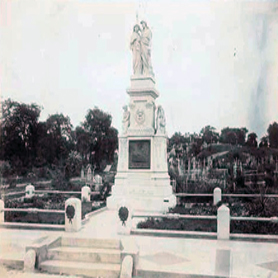Slocum Disaster Anniversary was held in All Faiths Lutheran Cemetery on Saturday, June 13, 2009 at the Slocum Memorial Monument. Speakers included former Councilman Tom Ognibene, Slocum historian Kenneth Lieb and JPCA President Robert Holden. All Faiths under the leadership of Dan Austin has continued the tradition of remembering the 1100 Slocum victims and the 61 unidentified buried at All Faiths.
The General Slocum worked as a passenger ship, taking people on excursions around New York City. On Wednesday, June 15, 1904, the ship had been chartered for $350 by the St. Mark's Evangelical Lutheran Church in the German district Little Germany, Manhattan. This was an annual rite for the group, which had made the trip for 17 consecutive years. Over 1,300 passengers, mostly women and children, boarded the General Slocum. It was to sail up theEast River and then eastward across Long Island Sound to Locust Grove, a picnic site in Eatons Neck, Long Island.
The ship got underway at 9:30am. As it was passing East 90th Street, a fire started in a storage compartment in the forward section, possibly caused by a discarded cigarette or match. The first notice of a fire was at 10am – eyewitnesses locate the initial blaze at several locations, including a paint locker filled with flammable liquids or a cabin filled with gasoline. Captain Van Schaick was only notified ten minutes after the fire was discovered – a twelve year old boy had tried to warn him earlier, but was not believed.
On board the Slocum, where the Captain has ultimate safety authority, no effort had been made to maintain or replace safety equipment. The ship's dryrotted fire hoses fell apart when the crew attempted to put out the fire. Likewise, the crew had never had a fire drill. Although the ship had lifeboats and life preservers, survivors reported that the life preservers were useless and fell apart in their hands. The lifeboats were tied up and inaccessible. Desperate mothers placed life jackets on their children and tossed them into the water, only to watch in horror as their children sank instead of floated, due to the condition of the jackets. Also, the population of the boat consisted mainly of women and children, most of whom could not swim.
It has been suggested that the manager of the life preserver manufacturer actually placed iron bars inside the Cork preservers to meet minimum weight requirements at the time. Many of the life preservers had been filled with cheap and less effective granulated cork and brought up to proper weight by the inclusion of the iron weights. Canvas covers, rotted with age, split and scattered the powdered cork. Managers of the company (Nonpareil Cork Works) were indicted, but not convicted.
Captain Van Schaick mishandled the situation badly. He decided to continue his course rather than run the ship aground or stop at a nearby landing. (Van Schaick would later argue he was attempting to prevent the fire from spreading to riverside buildings and oil tanks.) By going into headwinds and failing immediately to ground the vessel, he actually fanned the fire. Very flammable paint also helped the fire to spread out of control.
Some passengers attempted to jump into the river, but the women's clothing of the day made swimming almost impossible. Many died when the three-level floors of the overloaded boat collapsed; others were mauled by the still turning paddles as they attempted to escape into the water or over the sides.[2]
By the time the General Slocum was beached at North Brother Island, just off the Bronx shore, an estimated 1,021 people had been killed by fire or drowning, with 321 survivors. Two of the 30 crew members died. The Captain lost sight in one eye due to the fire. Reports indicate that Van Schaick deserted theSlocum as soon as it ran aground, jumping into a nearby tug, along with several crew. Some say his jacket was hardly rumpled. He was hospitalized atLebanon Hospital.
There were many acts of heroism among the passengers, witnesses, and emergency personnel. Staff and patients from the hospital on North Brother Island participated in the rescue efforts, forming human chains and pulling victims from the water.
http://en.wikipedia.org/wiki/General_Slocum
It is hard to ignore some eerie parallels between the General Slocum and World Trade Center disasters. In 1904, the number of casualties was never fully determined because there was no precise count of how many had boarded the ship. Heart-breaking scenes unfolded at a temporary morgue established on a pier, the only space large enough to accommodate so many victims. There was even a father who posted “missing” advertisements to locate a son he hoped had survived. As was true after September 11th, public charity and sympathy was extended to the victims, and surviving families. A memorial where remains of the unidentified deceased could be buried was dedicated only one year later in the Queens Lutheran Cemetery.
http://maggieblanck.com/Goehle/GeneralSlocum.html
For more information visit: http://www.junipercivic.com/HistoryArticle.asp?nid=15



